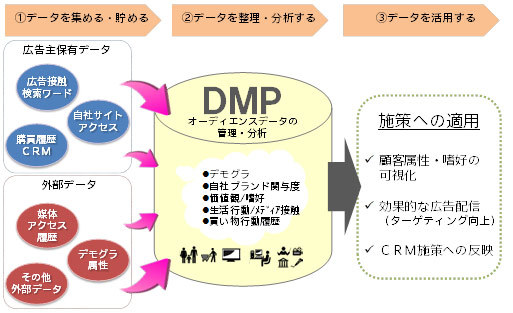As big data utilization in marketing gains full momentum, the core technology driving this shift is the DMP (Data Management Platform). DMP adoption is entering a phase of widespread implementation, with an increasing number of companies achieving tangible results. Koichiro Kondo, who promotes DMP implementation and operation at Dentsu Inc.'s Integrated Data Solutions Center, explains the practical application of DMPs.
The Era of "DMPs Being the Norm" is Finally Here
Since late last year, media companies, agencies, and consulting firms have been actively entering the DMP business. Within the ad tech solutions market, DMPs show particularly high growth rates, expanding 25-fold from 2012 to 2013. (Source: ITR http://www.itr.co.jp/company_outline/press_release/140109PR/index.html ).
The players for "people, tools, and data" are now in place: companies with talent capable of DMP strategy formulation and analysis, tools for high-speed big data processing, and data usable across diverse marketing initiatives. Preparations for market adoption are well underway. However, understanding the meaning and value of vast data and leveraging it for marketing with speed is no easy task. This series introduces the challenges advertisers face in successfully implementing DMPs and Dentsu Inc.'s approach.
DMP Extracts Data Value Through Three Processes
DMPs invariably involve three processes: ① data collection, ② data organization and analysis, and ③ data utilization. The core value DMPs provide lies in transforming vast amounts of data into something valuable for marketing through these processes. The Dentsu Group implements broad DMP utilization to enhance advertising ROI, extending beyond ad delivery, email distribution, and site optimization to include extracting insights for shifting marketing strategy itself.
DMPs are not magic boxes, now or in the future
Through client implementations and operations, we have come to deeply understand that DMP is not a magic box. Acquiring this new weapon of data simultaneously increases the things we must consider and the demands placed upon us. Furthermore, technical limitations remain, requiring us to accurately assess what is currently possible versus what will be possible in the future while designing our objectives. In this article, we will focus on each challenge through DMP case studies for brand advertisers.
Here, we present three key points advertisers should consider when operating a DMP, derived from insights gained in our most recent projects (detailed later):
Point ①: The Trade-off Between Segmentation Accuracy and Audience Size
Point 2: Accuracy of Each Individual Data Point Defining the Audience
Point 3: A Consistent Strategy for Data Collection, Segment Creation, and Campaign Execution
Creating good segments is like cooking: you need to understand the data = ingredients
When utilizing data, three key factors must be considered: quality, quantity, and price (collection cost). DMPs enable the creation of segments comprising customers with identical attributes and interests, allowing campaigns to focus on segments with high expected effectiveness. In this context, larger segment sizes and lower collection costs enhance cost-effectiveness.
Segments in a DMP are composed of diverse data. Understanding the quality, quantity, and price of data when building segments is fundamental—like understanding flavor, inventory, and cost when selecting ingredients for cooking.
When extracting user attributes and interests from behavioral data (site visits, searches, purchases, etc.), as opposed to survey or self-reported data, estimation is almost always necessary. Behavioral data carries numerous associated elements: the meaning/strength of the action (purchase > search > site visit, etc.), freshness (whether the action occurred yesterday or last year), and frequency. By classifying these elements based on human intuition or calculating similarity using methods like machine learning, we "estimate" the insights and attributes of the person who performed that action.
For example, someone who viewed a product's website versus someone who purchased the product clearly shows higher interest in the product (purchase > viewing). However, comparing someone who viewed the website multiple times in the past week to someone who made a single purchase a year ago, which person shows higher interest in the product? To correctly infer insights and attributes from data, understanding the elements of "meaning/strength, recency, and frequency" is essential.
DMPs can enhance data accuracy by adding frequency or freshness conditions, such as "viewed at least X times in the past week." However, applying such filters creates a dilemma: while improving accuracy, the segment shrinks, potentially losing the target audience (Point ①). Resolving this trade-off relies heavily on experience-based intuition.
Of course, segmentation using machine learning (decision trees, K-means, deep learning, etc.) can also be effective, not just human estimation. However, it is necessary to understand the strengths and weaknesses of each method, along with their input parameters and outputs.
Verifying targeting accuracy through panel data integration
DMPs can do more than just enhance targeting accuracy as described above. By integrating with Dentsu Group's survey panel data, they can also help refine evaluation metrics and optimize digital advertising budgets.
Digital advertising targeting products are generally built based on website navigation behavior. But how much reliable insight can actually be gleaned from this navigation behavior (Point ②)?
In the Dentsu Inc. Group's DMP project, we integrated survey panel data with data on individuals exposed to targeted ads to verify the "true target inclusion rate" among those exhibiting "target-like behavior" (e.g., individuals who have purchased the product). We found that even in segments expected to have a high inclusion rate of actual purchasers, non-target individuals often constituted the majority. This "verification" allows us to refine simple reach costs into more precise reach costs, enabling us to identify ads that are actually achieving their intended objectives.

For example, as shown in the figure, factoring in the target inclusion rate reverses the evaluation of advertising menus A and B. In practice, refining the evaluation of advertising menus using DMP has led to significant changes in advertising budget allocation, resulting in dramatically improved cost-effectiveness. Integrating data enables media budget allocation that pursues more fundamental advertising effectiveness, even for hard-to-estimate behavioral data.
※Part 2 scheduled for September 2.
Mr. Satoshi Saeki from the same center will continue explaining practical DMP implementation.



